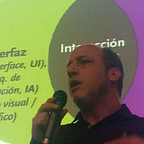If this is the “seat at the table” we get as UX, it’s time to stand up.
The Three Decades of UX
1993–2003: Conception. Back in 1993, Don Norman envisioned UX as a discipline beyond usability and interface design: understanding and improving all user and customer interactions and experiences.
2003–2013: Growth. In 2003, Bruce Tognazzini (a partner of Don Norman) declared: “it’s time we got respect,” leading to the founding of IxDA, a voluntary and nonprofit association with the mission to improve the human condition by freeing it from poor experiences.
Many of us joined the challenge of building a professional community that, with integrity, would promote this mission in education and industry.
2013 to Today: Decline. Some took another path: to get into big companies and secure “a seat at the table,” they chose to compromise aspects that challenged business decisions.
Ten years of corporate bullshit later, they have created teams that not only produce screens that punish customers but also proudly announce their accomplishments, boasting about being part of a team of “geniuses.” They brag about being “this team that kills it” (in spanish: “este equipo que la rompe”).
And it’s true; they really do “kill it.”
Professional ethics and integrity? Killed. Fundamental design heuristics and rules? Killed. Best practices, productivity, and customer nerves? Killed. The reputation of “UX”? Killed.
They kill everything.
Jesse James Garrett, pioneer and author of “The Elements of User Experience,” wondered in 2021, “Where did we go wrong?”:
Instead of challenging teams to stretch their thinking to address deeper and subtler user needs, product design practices have become increasingly less insight-driven (…)
Too many UX leaders have seen the field’s language and ideas co-opted and corrupted by outsiders who never knew or cared about the principles underlying the practices. (…) Businesses cherry-picked the bits of UX most compatible with their existing agendas and eschewed the parts that might lead to uncomfortable questions that could influence more than the color of a button on a screen.
The current situation is the inevitable result of bowing to corporate bullshit to get “a seat at the table.” And that’s how they gave you a high chair, a bib, and colored crayons. So you can join the corporate bullshit, applaud business whims, and legitimize their view of their customers: sheep to be exploited.
Sheep are born to be fleeced. Their time, their suffering, their effort, it doesn’t matter: it has no cost to the business. Is something hard to use? Well, the sheep will have to dedicate time to it. Time making mistakes, time getting frustrated, time with the chat that responds with nonsense, time with the phone that doesn’t answer.
To understand and address the complaints, claims, and needs of users and customers, the business says “there’s no time.” A complete absurdity: time isn’t something you “have” or “don’t have.” It’s not something you can store in a drawer. Time is something you allocate.
So, when the business says “there’s no time,” what it’s really saying is “I don’t care.” Because no one ever explained to them why they should care. If you have integrity as a UX professional, your role in this situation is to explain to the business the business and ethical reasons why it does matter.
User experience is the establishment of a philosophy about how to treat people. — Whitney Hess
But of course, it’s easier to say “they told me no” and “that’s how it is here,” than to assume your authority and responsibility: you’re supposed to be hired to do a job, and you’re the person who knows how to do it. If you shrink when the business challenges you because they don’t understand why they hired you, the message you’re sending is very clear: your role, and that of all of us who work in UX, is to bow our heads and make pretty screens.
One of these “teams that kill it” has been working for 7 years with a Home Banking system that doesn’t allow copying and pasting data when making a transaction. A functionality invented in 1974, killed. 50 years of UX standards, killed. It seems that in 7 years they “didn’t have time” to fix that.
A new decade begins. How it will be remembered depends on us.
At the first IxDA BA event in 2009, I declared: if we don’t set high professional standards and lead by example, our discipline (at that time, we spoke of “interaction design”) will become synonymous with web design.
Since then, many of us have taken on that responsibility, convinced that bullshit must be fought at its roots. It should never be ignored, because otherwise, it eats away at professional integrity.
Others, sooner or later, chose differently. They chose to sell their integrity and professional reputation for a little chair and a little title. They chose to climb onto the shoulders of corporate bullshit, pretending from there to be successful and the model to follow.
We owe them the past decade of decline. They will be remembered, at least for a little while: as an example of everything not to do.
To the others, those who want to lift our discipline out of the pit: follow me the good ones! (in other words, like & subscribe).
Let’s design together the new decade of UX: the renaissance.
